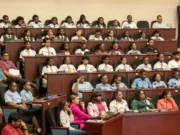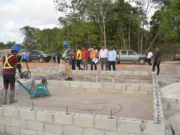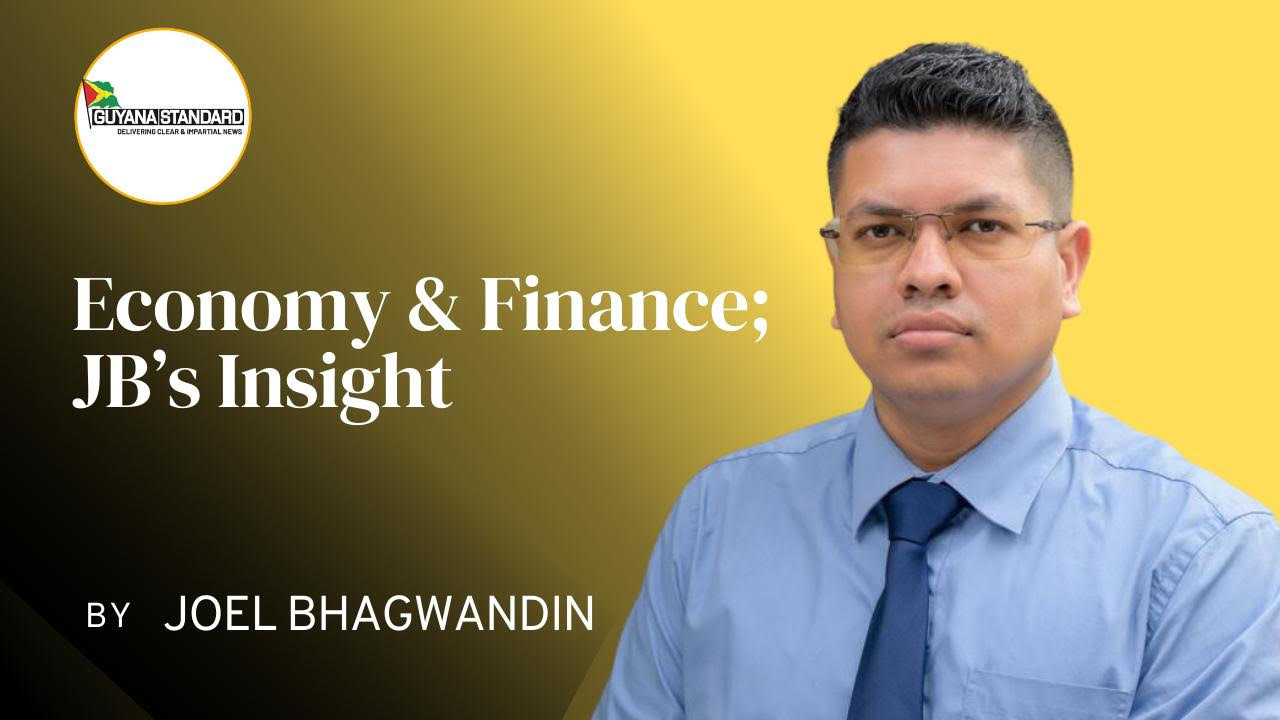Summary
To understand where the Guyana is projected to be in the future, one has to understand and appreciate its economic history. Historically, Guyana was once a Centrally Command State where more than 80% of the productive sectors were controlled by the State. In the post 1992 era, Guyana transitioned from a Centrally Command and Bankrupt State to a mixed-economic system with more predominant features of a market economy. Guyana’s debt-to-GDP stood at over 900% at one time in our history (over three decades ago).
The argument put forward by Tom Sanzillo et.al on the Newsmakers interview are evidently not grounded in empiricism. The views expressed are woefully uninformed. The government of the day has a good understanding of the peculiar challenges for the country’s development and economic transformation. Those challenges are being addressed frontally. Notably, work is currently ongoing to develop, update, strengthen and enhance all of the requisite frameworks including the legislative framework―that will enable the next wave of development towards the latter half of the decade and onwards.
1. Background
In a panel interview aired recently by “The Newsmakers” on the topic “will Guyana’s oil wealth bring prosperity or turmoil”, in a typical white supremacist style, Tom Sanzillo pronounced his views on Guyana’s oil and gas industry. Sanzillo argued that Guyana does not need the road networks and gas-to-shore project that the country is advancing. He further argued that the Natural Resource Fund (NRF) is not designed to build up savings at the outset similar to Norway. Instead, he contended that the government is utilizing the funds to expend on capital projects solely to retain political power. This type of behavioral posture by Sanzillo is unarguably highly misinformed, mischievous, divorced from reality and the Guyanese context altogether. And worse, Sanzillo is given a platform in Guyana by Guyanese to propagate this sort of “white supremacists” commentary. Additionally, the other panelists on the interview held the collective view that the Government of Guyana does not have a clear vision how to develop the country in a sustainable manner and how to confront the inherent developmental challenges. This article is dedicated, therefore, in response to the foregoing contentions by Tom Sanzillo et.al.
2. Discussion and Analysis
The NRF Fund and Withdrawal Rules
The withdrawal rules of the NRF are NOT designed to withdraw all of the funds especially as the balance in the fund starts to grow. The upfront drawdown from the fund is necessary to accelerate and advance Guyana’s development agenda in infrastructure (new roads and bridges, drainage & irrigation, social infrastructure, health care, education, national security, and ICT etc.) all aimed to modernize and transform the economy and diversify the economy away from oil and gas. This is in keeping with a sustainable development model, thus preventing the economy from being exposed to any significant risks of bankruptcy and external shocks.
Important to note as well is that the investments of today are for the benefit of the future and present generations. The new four-lane roads that are being built, investment towards a modern education system, cheaper energy, etc., will be enjoyed by the present and future generations.
Given where Guyana is today and its development needs of today, the government cannot only save for the future generation, but has to invest in the facilities, infrastructure, education system etc., today, for the future generation to enjoy.
Economic History
To understand where the economy is projected to be in the future, one has to understand and appreciate its economic history. Historically, Guyana was once a Centrally Command State where more than 80% of the productive sectors were controlled by the State. In the post 1992 era, Guyana transitioned from a Centrally Command and Bankrupt State to a mixed-economic system with more predominant features of a free market economy. Guyana’s debt-to-GDP stood at over 900% at one time in our history (over three decades ago).
Current Economic Landscape
❖ The Debt-to-GDP ratio is down from 900% more than three decades ago to less than 30% as of 2022.
❖ GDP grew from US$200 million to US$14 billion and non-oil GDP stood at US$5 billion as of 2022.
❖ Per capita income increase from less than US$500 in 1992 to US$9,000 as of 2022.
❖ The foreign reserves of the country stood at U$900 million at the end of 2022.
❖ The net foreign assets in the commercial banking sector stood at over US$400 million as of 2022.
❖ The incumbent Administration has managed to eradicate extreme poverty over the past three decades.
❖ From more than 90% poverty over the last three decades, poverty levels is not an estimated 40% of the population (based on dated studies).
Development Challenges
❖ Historically many attempts to destabilize the Government, political instability.
❖ High energy cost inhibiting private sector growth, Infrastructure deficit.
❖ Human capital deficit where less than 5% of the labour force possess a tertiary level education; historically, owing to Guyana’s economic, political, and social challenges there were mass emigration.
❖ Improving the ease of doing business.
Development Needs
Accelerating Guyana’s development needs essentially means accelerating the strategies that have been developed decades ago that were not fully accomplished due to the development challenges highlighted above. Guyana’s Development needs have been well articulated and identified since 1996 in the National Development Strategy of 1996, National Competitiveness Strategy (2006), Low Carbon Development Strategy (2009) now being updated and expanded. The development needs of the country can be summarized as follows:
❖ Currently, Guyana has a major infrastructure deficit: Infrastructure needs include roads, bridges, ports, moving development towards the South (inland), new Secondary City to be developed (Silica City);
❖ Climate resilient infrastructure,
❖ Modern Public Health Care and Infrastructure,
❖ Making Education affordable and accessible, overhaul the Education curriculum, designed to equip the future labour force with the skills and competences for the future economy,
❖ Government is aiming to provide free tertiary education by 2025,
❖ Affordable housing across the country targeting 50,000 new homes by 2025,
❖ Strengthening National Security,
❖ Investing in people, human resources especially within the public sector, better wages, salaries, and working conditions.
❖ In terms of the skills deficit, Government is confronting this by making available over 20,000 scholarships by 2025, free tertiary Education, investing in non-academic training such as TVET, and in the interim, an immigration policy is being developed. In the absence of an immigration policy, however, expatriates are filling the gap in the private sector, and this is not only in the oil and gas sector, but across other sectors.
Economic Transformation
Major transformational projects include but are not limited to:
❖ The gas-to-shore project aimed at reducing energy cost by 50%. It should be noted that this is not the only benefit this project will derive once implemented. A cost benefit analysis done by this author about a year ago showed that the savings in the country’s fuel import bill, export earnings from exporting the liquefied natural gas (once there is excess), cheaper cooking gas for domestic use, and the potential positive impact on the manufacturing sector―can translate to an estimated US$1 billion in net benefit annually to the economy.
❖ Economic transformation within the framework of the inevitable structural transformation of the economy from a largely primary producing economy to a tertiary producing economy. Major focus and investment in economic diversification, Agriculture, Agro-processing, the Services Industry, Manufacturing, ICT, and Eco-Tourism.
❖ Regional food and energy security agenda to tap into a US$5b and US$9b market, respectively.
The Capital Budget
The capital budget is premised on a national development framework which began three decades ago under the incumbent government, viz-á-viz, the National Development Strategy (NDS) (1996). The NDS is a seven-volume document with over 3,000 pages. If one were to peruse this document one would recognize that all of the infrastructure and physical development program, in particular, the tourism development strategy among other things that the Government is advancing, were all identified in that NDS framework. The need to revisit the feasibility of reintroducing railway networks with respect to the development of the transportation sector– aimed at reducing the logistical cost in transporting goods in bulk across the country and of course connecting the country through rail networks once again to enable cost effective and efficient movement of goods and people, is articulated in the NDS.
It is worth noting at this point that in respect of reintroducing railways, beyond connecting the country through rail networks, Guyana is now in a position where over the long term, policymakers may need to consider integrating Guyana in South America through rail networks which will open up new opportunities and access to a larger market within the South American continent. The NDS, over the years was subsequently complemented by the National Competitiveness Strategy (NCS), the Low Carbon Development Strategy (LCDS) which has been recently updated and expanded to include the blue economy, and the manifesto commitments of the Government upon which it was elected.
Cost of Living
The Government implemented several measures to combat the cost-of-living issue which is largely impacted by external factors within the global economy. To this end, the inflationary pressure is driven by two forces: (1) imported inflation attributable to the fact that Guyana imports more than 80% of consumption goods, intermediate and capital goods. This aspect of inflation is impacted by events in the global economy such as supply chain disruptions leading to cost push inflation and demand-pull inflation. (2) Secondly, the inflationary impact within the domestic economy is driven by strong domestic demand across all sectors as demonstrated by the vibrant double-digit growth in the overall economy and in the non-oil sectors. The total estimated cost of the COL measures implemented by the government in terms of direct cost to the treasury and foregone revenue to the treasury–is approximately $89 billion. This represents 11.3% of the total budget, 28% of current revenue, and 43% of the NRF withdrawal to finance budget 2023.
Contrary to the views expressed by the hostess on the Newsmakers interview that cost of living in Guyana has soared, inflation at the end-2022 was an estimated 7.2%, 1.5 percentage points below the global average of 8.7%. Of note, this achievement is attributed to the COL interventions by the government. Countries such as the United Kingdom, Canada, and Turkey recorded higher inflation rates in 2022 of 10.1%, 7.6% and 79.6% respectively, just to name a few.
3. Concluding Remarks
With all of the aforementioned in mind, the argument put forward by Tom Sanzillo et.al on the Newsmakers interview are evidently not grounded in empiricism. The views expressed are woefully uninformed. The government of the day has a good understanding of the peculiar challenges for the country’s development and economic transformation. Those challenges are being addressed frontally. Notably, work is currently ongoing to develop, update, strengthen and enhance all of the requisite frameworks including the legislative framework―that will enable the next wave of development towards the latter half of the decade and onwards.
About the Author
Joel Bhagwandin is a public policy/financial analyst―and an experienced financial professional with more than fifteen years’ experience in the financial sector, corporate finance, financial management, consulting, and academia. He is actively engaged in providing insights and analyses on a range of public policy, economic and finance issues in Guyana over the last six years. He has authored more than 300 articles covering a variety of thematic areas. Joel has also written extensively on the oil and gas sector. (Author’s professional profile on LinkedIn can be accessed here: https://www.linkedin.com/in/joel-bhagwandin-57481470/.)













